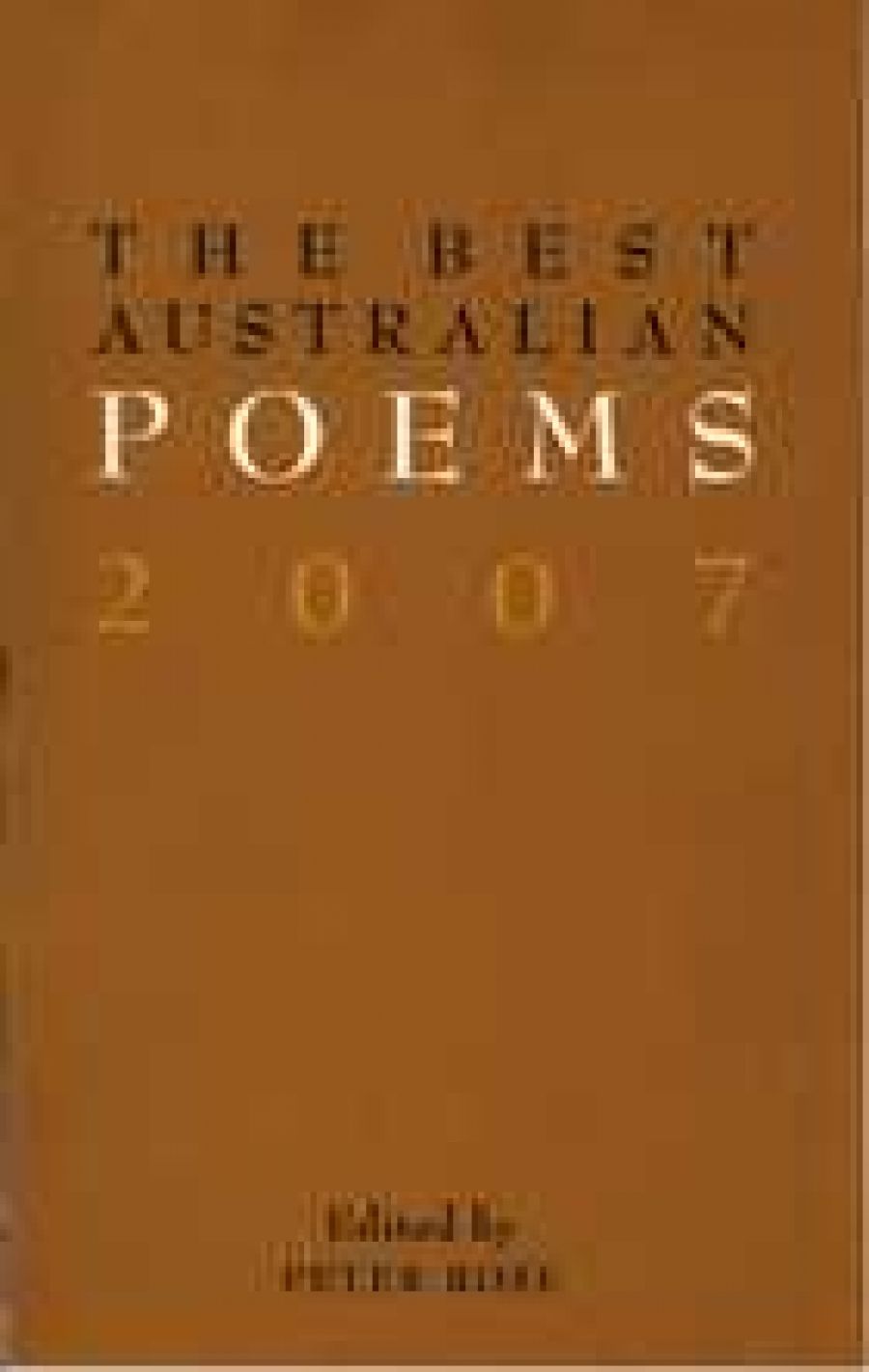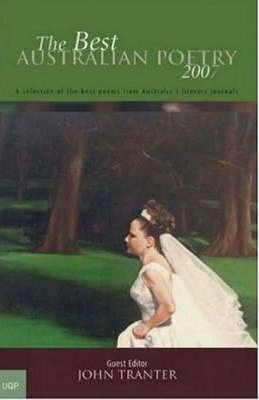
- Free Article: No
- Contents Category: Poetry
- Review Article: Yes
- Online Only: No
- Custom Highlight Text:
Given the Howard government’s recent proposal to include the compulsory study of selected aspects of Australian history for secondary school students, perhaps it is time for more educators to follow the lead of Nicholas Jose and others in urging that Australian literature occupy a more prominent place in the school curriculum. Literature – and poetry in particular – does not have the political buzz that history possesses (especially since the recent ‘history wars’ have worked their way into public discourse), but there is a need for some healthy consciousness-raising about the flourishing state of Australian writing, which is often better understood beyond our shores than it is at home.
- Book 1 Title: The Best Australian Poems 2007
- Book 1 Biblio: Black Inc., $24.95 pb, 130 pp
- Book 2 Title: The Best Australian Poetry 2007
- Book 2 Biblio: University of Queensland Press, $24.95 pb, 101 pp
- Book 2 Cover Small (400 x 600):

- Book 2 Cover (800 x 1200):

- Book 2 Cover Path (no longer required): images/1_SocialMedia/2021/Jan_2021/9780702236075.jpg
And what better place to start than with some recent anthologies? Would that every secondary school library in the nation could add these two recent collections of contemporary poetry (and their companion short-story anthology) to their shelves. Poetry is usually ‘taught’ – when it is taught at all – as a single-author study, from a ‘list’ (often unchanged for years) taken from the Selected Works of Bruce Dawe, Gwen Harwood, or Les Murray. How much better it would be to allow students to read widely among the poems contained in one of these anthologies, and to supplement their experience with ‘author study’. John Tranter and Peter Rose are not only fine poets but also fine and experienced readers and editors of Australian poetry. Tranter, the founder of the popular online journal Jacket, has since New Australian Poetry (1979) compiled some of our best anthologies; Rose, as editor of ABR, consistently promotes the best contemporary verse. In their introductions, both editors lament the paradoxical marginalisation of poetry at a time when there is a plenitude of good verse. Tranter draws attention to the silent expulsion of poems from the pages of daily newspapers, and Rose makes this timely comment:
A culture that is indifferent to poetry is deficient and derelict. No young person’s education can be deemed complete without a rich and active appreciation of poetry, but how will they hear about it if we don’t voice it and feel its force – if it is not a potent feature of the culture in the first place?
Black Inc. gives its poetry editor rather more scope than UQP – sixty-five poems, against forty – but both collections present an invigorating mix of the recent work of poets new and well-known. The alphabetical democracy of the anthologies sits Louise Nicholas between Les Murray and Ouyang Yu (Tranter), and David Rowbotham next to Brendan Ryan (Rose). Such juxtapositions of voice make for exciting reading. Like many readers of anthologies, I skimmed first in search of old favourites – Dawe, Murray, Robert Adamson, Rosemary Dobson, David Malouf, Tom Shapcott, David Rowbotham, Chris Wallace-Crabbe, two very different Porters – and was not disappointed. These canonical poets retain their power to ‘make it new’. In the Black Inc. book, ‘White-Water Rafting and Palliative Care’, Dawe’s elegy for his late wife, rings breathtaking changes on the age-old trope of the ‘bark of care’:
If I had understood (when down the river
you and I went swirling in that boat)
that there were those who knew the ways of water
and how to use the oars to keep afloat …
How eloquently Dawe, always the master of plain style, speaks to and for men who fear the unmanliness of tears. His poem sits beautifully beside Dobson’s Nativity poem, ‘Aspects of Holiness’; she too dares to write simply and directly of ‘the holiness of the heart’s affections’:
Gislebertus, Sculptor of Autun,
Carved on one capital in relief
The journeying Kings’ humility –
Three in one truckle-bed asleep,
Each with his crown upon his head.
Wonderful, oh wonderful!
Tranter, too, makes some fine choices from the new work of Australia’s vintage poets. Clive James’s ‘A Gyre from Brother Jack’, like Dobson’s poem, pays tribute to a work of visual art, in this case Jack Yeats’s ‘A Morning Long Ago’. Such poems run the risk of failing to achieve an effect if the reader is not familiar with the work in question; this one is eloquent in its own right, and inspired this reader at least to look for a reproduction of the canvas which hangs in Dublin. It illuminates the painting. Rose also includes a James poem, ‘Special Needs’, this one moving in a more personal way. Both editors include – how could they not? – poems by Les Murray. They are strikingly different, and illustrate well the range of Murray’s idiom.
Reading the contents of these anthologies sequentially, one soon comes to appreciate an incidental virtue of what Tranter calls ‘the democratic alphabet’. In a curious variation on Plus ça change, plus c’est la même chose, the arrangement of poems results in frequent felicitous linkings and pairings, such as the placement of the poems by Dawe and Dobson in Rose’s selection. John Tranter’s book begins with Robert Adamson’s ‘Double-eyed Fig Parrot’, a meditation on the visual (and by extension the verbal) artist’s endeavour to transmute the mysterious life of nature into work on paper. The reader is compelled to return to it after reading Judith Bishop’s ‘Still Life with Cockles and Shells’ on the next page. There is the intriguing sense of a dialogue between these two beguilingly understated variations on the theme of ars longs, vita brevis, unintentional of course, but persuasive nevertheless. (Is this the Year of the Parrot in Australian poetry? Adamson’s poem resonates powerfully against Richard Hillman’s ‘The Night Parrot’ in Rose’s anthology.) There are other synergies of propinquity in The Best Australian Poetry, such as that created by the poems of Poona Mittal and Reg Mombassa; although their verbal effects are different (hers understated, his flamboyantly explicit), both create disturbing images of sexual violence and betrayal.
Seventeen of the forty poets chosen by Tranter appear in Rose’s longer selection. This is a relatively small overlap, which argues for the health of the body poetic; only one poem appears in both anthologies, S.K. Kelen’s cryptic ‘Dance’. (I admit to being baffled by this one, and the author’s note didn’t give me much help: ‘A bit of fun, perhaps?’) Each editor includes a poem by the other, and good poems they are. We have come a long way from the Angus & Robertson Australian Poetry annual volume; its importance for the dissemination of Australian poetry was inestimable, but some of its editors allowed their allegiances to mates to influence their choice of contents, to the detriment of quality.
Rose casts his editorial net somewhat wider than Tranter, in that he includes poems published outside Australia. The two anthologies are almost as close in form as they are in title, with the only significant difference being that the series editors of The Best Australian Poetry 2007 allow poets to include explanatory and explicatory notes in their biographical entries. Sometimes these comments are helpful, as in Jill Jones’s remarks on how she composed her ‘Waking Alone By the Radio’, and Michael Riley’s telling us that the toenail-clipping ‘Sarah’ of his ‘Alice Springs’ is the family cat. But surely any poem worth its salt should be able to walk without crutches. John Kinsella and John Millett write annotations that are much longer than the poems they address, which argues an odd lack of confidence in their considerable abilities. Surely every possible effort should be made to discourage the asking of that question which still pops up in examinations and class discussions – what do you think the poet is trying to say?
Tranter’s selection seems to have been guided by the principle that his fellow editor articulates: ‘I have looked for poetry that is, if not reductively personal, then highly expressive and resonant and open-hearted …’ Resonance is a slippery term to define, of course, because it is highly dependent on the experience that each of us brings to those black marks on the page. The resonance of some of Tranter’s choices is a matter of their referentiality to other works of art. The Clive James poem, already mentioned, is a case in point, as are the poems by James Hetherington, Jennifer Harrison, and David McCooey. Harrison’s ‘Baldanders’ baffled me at first, until I got past the Borges epigraph to think about the shape-changing shoemaker Hans Sachs and his descendant Simplicissimus. It is a very fine poem, but the poet’s explanatory note here is clearly in order!
A different sort of challenge is posed by one of Rose’s inclusions, J.S. Harry’s ‘Thales of the Pre-Socratics’, until one understands that it is part of a sequence, and makes the effort to seek out the whole poem. The editor has taken a risk here with ‘expressiveness’ and ‘resonance’, but it was one worth taking – it’s another lively, innovative and well-crafted piece of writing.
Tranter’s choices tend to be metropolitan poems. Rose clearly has a taste for works which focus on the experience of country Australia, though perhaps this is a product of the author of Donatello in Wangaratta (1998) having a larger anthology to work with. Even if ‘thematic’ readings have a whiff of the schoolroom about them, it is pleasant to read the poems by Chris Andrews, Ross Clark, Kathryn Lomer, Craig Sherborne, and Jennifer Strauss as a kind of minianthology, and to think about the ways in which they speak to one another. Strauss’s ‘Country Town’, incidentally, is a much better poem than Kenneth Slessor’s sentimental elocution-piece ‘Country Towns’.
The editors make similarly wry comments about their task of choosing ‘best’ poems, but let us be thankful to them (and to their publishers, and to the series editors at UQP) for doing what they have done so very well. ‘When was the last time you heard a poem being discussed around a dinner table?’ asks Rose. Now that another summer is upon us, let us imagine for a wistful moment that at barbecues and dinner parties guests are asked to choose their ‘best’ poems from these collections. My choices are for two of the ‘ancients’, despite the scintillating allures of some of the ‘moderns’: Chris Wallace-Crabbe’s ‘A Vocation’ (from Tranter), and David Rowbotham’s ‘All Wars’ (from Rose). Yours?


Comments powered by CComment